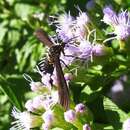Comprehensive Description
provided by Smithsonian Contributions to Zoology
Horama panthalon texana (Grote)
Euchromia plumipes.—Clemens [not Drury 1773], 1860:546.
†Euchromia pretus.—Clemens [not Cramer 1777], in Morris, 1862:276. [Listed as “Var.” under E. pretus]
Callicarus texanus Grote, 1866:184.—Butler, 1876:372.—Druce, 1884:49; 1897:338.
Horama texana Grote, 1868:116.—Grote and Robinson, 1868: vi.—Hampson, 1898:418, fig. 217.—Dyar, 1902[1903]:77.—Holland 1903:100, pl. 13: fig. 9.—Zerny, 1912:122—Draudt in Seitz, 1916:143, pl. 21: row h.—Barnes and McDunnough, 1917:29.—McDunnough, 1938:44.
Phylloecia texanus.—Kirby, 1892:129.
Phylloecia texana.—Neumoegen and Dyar, 1893:100.
MALE.—Similar to the typical p. panthalon phenotype except for the following: base of second palpal segment usually banded with black scales; fore and midlegs bluish black, distal half of hind tibiae banded with long black hirsute scales; hind tarsi ochreous orange with two rows of short, hirsute scales; both wings dark brown except for some buff yellow scales along costa of hind wing. Underside: both wings lighter brown with bright ochreous-orange patch at base of hind wing along costa. Venation almost identical to panthalon (Figure 24a) but with several variations (Figure 24b,c). Alar expanse 34–37 mm.
MALE GENITALIA.—Not distinguishable from that of the typical panthalon (Figure 3a,b).
FEMALE (Plate 1: figure 6).—Same as the male except slightly larger. Alar expanse 35–38 mm.
FEMALE GENITALIA (cf. Figure 15).—Similar to that of the typical panthalon.
TYPE.—Lost. Apparently without seeing Clemens’ specimens, Grote (1866) established Callicarus texanus by quoting verbatim Clemens’ (1860) description for Euchromia plumipes. The only type information given by Clemens is “Texas. Coll. Capt. Pope. Smithsonian Institution.” We have been unable to locate any specimens in the national collection that fit this information nor does the Philadelphia Academy of Sciences, which has some Clemens material, have any record of it (Emsley in litt.). There are four specimens in the national collection with the identical label “Tex.” but each has a different collection label (C. V. Riley, E. L. Graef, or H. G. Dyar). There are no specimens specifically labeled from the Pope collection.
TYPE-LOCALITY.—Texas.
HOST PLANTS.—None recorded. Adult has been collected at Wislizenia refracta var. mamillata [Capparidaceae].
DISTRIBUTION (Map 1).—Southern Texas, Florida, and Arizona, Mexico and Guatemala.
- bibliographic citation
- Dietz, Robert E. and Duckworth, W. Donald. 1976. "A review of the genus Horama Hübner and reestablishment of the genus Poliopastea Hampson (Lepidoptera: Ctenuchidae)." Smithsonian Contributions to Zoology. 1-53. https://doi.org/10.5479/si.00810282.215

